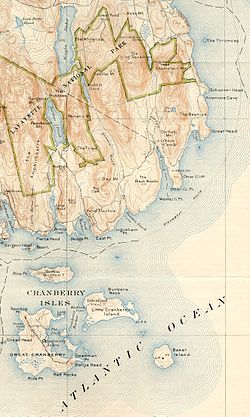- Otter Cliffs Radio Station
-
Coordinates: 44°18′45″N 68°11′36″W / 44.3125°N 68.19333°W
Otter Cliffs Radio Station Acadia National Park, Hancock County, Maine
Otter Cliffs Radio Station location, 1922Built 1917 In use 1935-2002 Current
conditionDemolished Current
ownerNational Park Service Controlled by Acadia National Park U.S. Naval Radio Station Otter Cliffs was a United States Navy radio receiver facility located in Acadia National Park on Mount Desert Island, south of Bar Harbor, Maine.
The station was commissioned on August 28, 1917, under the command of Lt. Alessandro Fabbri, who had personally cleared the land, built and equipped the station, and offered it to the government in exchange for a commission in the Naval Reserve and assignment as Officer-in-Charge.
Otter Cliffs was the Navy's best transatlantic radio receiver site because of its absence of nearby man-made radio noise, its unobstructed ocean path from Europe, and the outstanding receivers, antennas and noise mitigation techniques developed by the Wireless Specialty Apparatus Company under the leadership of Greenleaf Whittier Pickard. Pickard is well-known for his early inventions in connection with loop aerials, direction-finding systems and static mitigating devices used at Otter Cliffs during the war. His technical achievements and illustrations of equipment at Otter Cliffs during the war were documented in detail in the Proceedings of the IRE.
Edmond Bruce, a Navy enlisted man, served as chief electrician for the transatlantic receiver during the war. He later became a widely recognized radio engineer and inventor.
By the end of the war, over 100 Navy enlisted men and 25 Marines were assigned to the station. By 1933, however, its buildings had become dilapidated and Navy funds were not forthcoming for repairs. When John D. Rockefeller, Jr. suggested that it be removed, the Navy agreed to include the station in his donation to Acadia National Park, provided that he would build an equally good receiving station nearby. He did so at the Schoodic Peninsula's tip, about five miles away across Frenchman Bay, and Feb. 28, 1935 Otter Cliffs was decommissioned and the new Winter Harbor station was commissioned. (It later became Naval Security Group Activity, Winter Harbor, and on July 1, 2002, was decommissioned and transferred to the National Park Service.)
- Portions of this article are derived from the following news story, which as a product of the United States Government is not subject to copyright: "End of an Era: NSGA Winter Harbor to Close Its Doors", Story Number: NNS020321-08, 3/21/2002, by Journalist 1st Class Sarah Urban, Naval Security Group Activity Winter Harbor Public Affairs.
See also
References
- Radio NBD, Otter Cliffs, Maine
- End of an Era: NSGA Winter Harbor to Close Its Doors
- Otter Cliffs under command of Fabbri
- Otter Cliffs under command of the Transatlantic Communications Officer
- Lease of Fabbri's amateur radio station
- Map of Radio NBD
- Obituary of Allesandro Fabbri
- U. S. Naval Cryptologic Veterans Association, by George P. McGinnis, Turner Publishing Company, 1997
- Static Elimination by Directional Reception; Proceedings of the IRE; October, 1920; pages 358-394
- Fabbri Picnic Area at Otter Cliffs
- The Breeding Place of Static discovered
Categories:- Mount Desert Island
- United States Navy facilities
- Military facilities in Maine
- Buildings and structures in Hancock County, Maine
Wikimedia Foundation. 2010.

